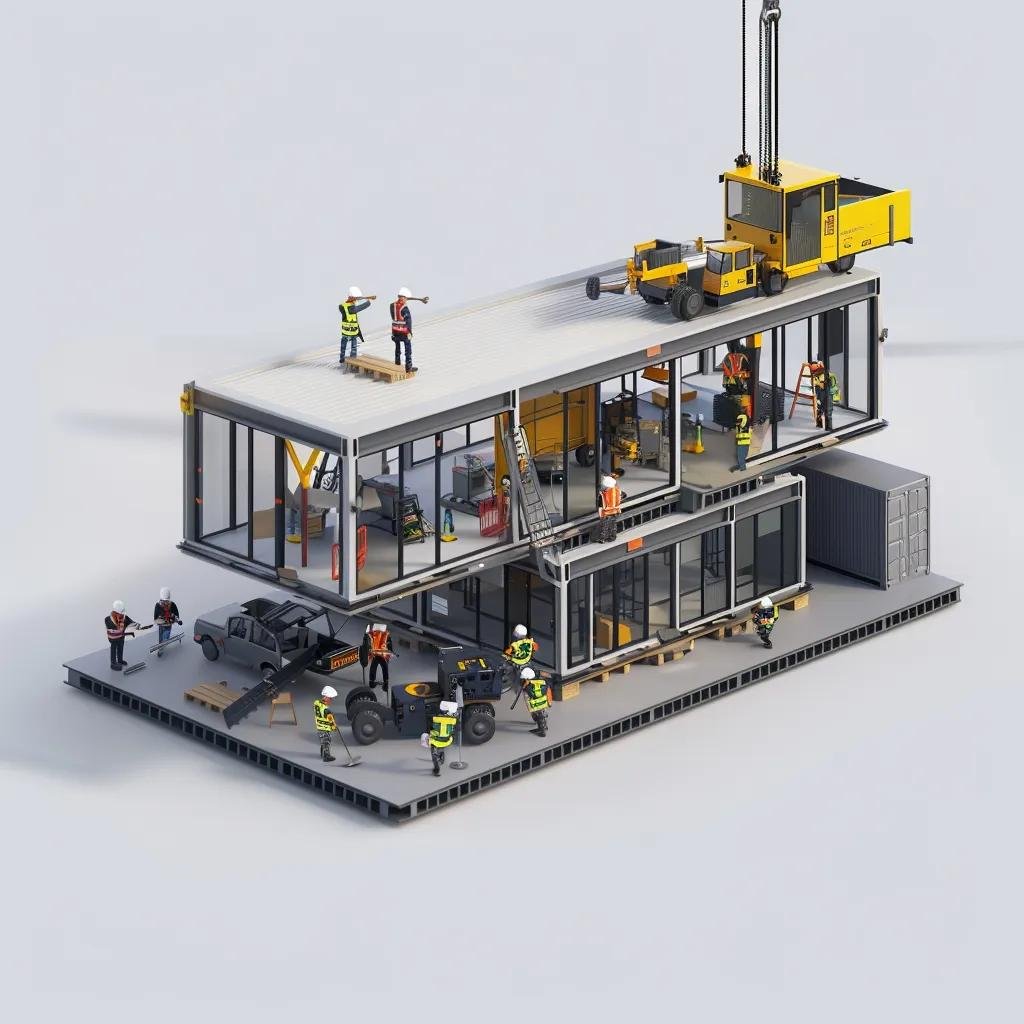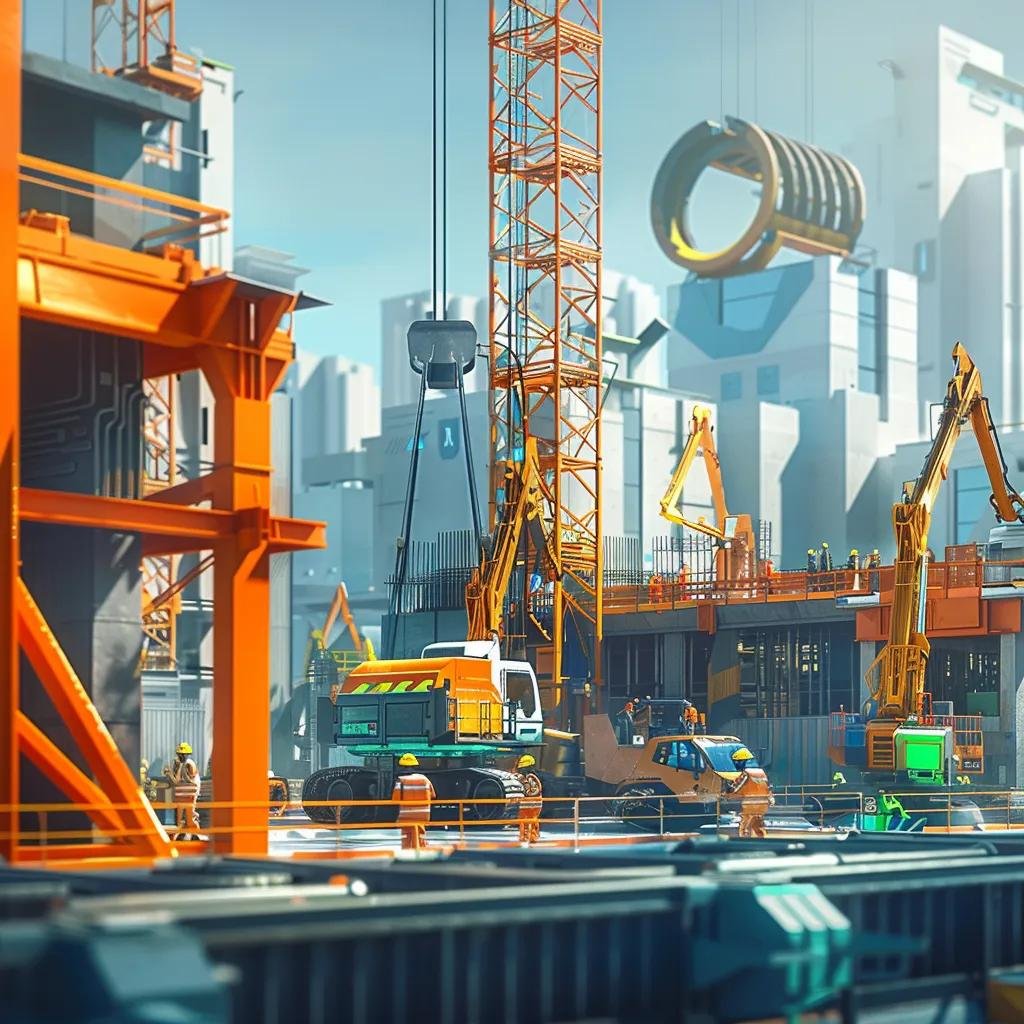Latest Trends in Commercial Construction: Innovations, Sustainability, and Industry Challenges
Commercial construction is on the cusp of a transformation driven by cutting-edge digital tools, eco-friendly materials, and automated methods that promise faster delivery, reduced costs, and greener operations. In fact, the U.S. commercial construction market is projected to grow from $567 billion in 2025 to $695 billion by 2030, fueled by advances in BIM, AI, and sustainable design.
Market Growth Projections
The U.S. commercial construction market is projected to experience substantial growth, increasing from $567 billion in 2025 to $695 billion by 2030. This expansion is fueled by advancements in Building Information Modeling (BIM), Artificial Intelligence (AI), and sustainable design practices, indicating a dynamic and evolving industry landscape.
This projection supports the article’s introduction, highlighting the industry’s growth trajectory and the factors driving it.
This article explores the latest trends in commercial construction, mapping key technology innovations, sustainability drivers, modular methods, smart building systems, industry challenges, maintenance implications for modern facilities, and a forward-looking market outlook. Along the way, we show how Mastodon Marketing’s tailored air duct cleaning services and commercial cleaning services ensure optimal performance and indoor air quality for next-generation buildings.
What Are the Key Technology Trends Shaping Commercial Construction?
Key technology trends in commercial construction encompass digital modeling, artificial intelligence, automation, and immersive visualization that streamline workflows, enhance decision-making, and reduce rework.
How Does Building Information Modeling (BIM) Improve Commercial Projects?
Building Information Modeling (BIM) is a 3D model–based process that integrates design, cost, schedule and facility data into a single virtual representation to improve coordination and decision-making. By detecting clashes early and automating quantity takeoffs, BIM reduces costly on-site errors and accelerates permitting. Improved collaboration among architects, engineers, and contractors drives up to 15 percent time savings. As BIM aligns teams, the next step leverages AI for deeper analytics.
What Role Does Artificial Intelligence (AI) Play in Construction Efficiency?
Artificial intelligence (AI) applies machine learning algorithms to analyze project data, predict resource needs, and optimize schedules, boosting productivity and reducing cost overruns.
Key AI applications include:
- Predictive scheduling that forecasts delays and reallocates crews proactively.
- Quality control through image recognition that spots defects on-site.
- Resource optimization that allocates materials based on real-time usage.
These AI-driven insights set the stage for robotics and drones to automate physical tasks with precision.
How Are Drones and Robotics Transforming Construction Sites?
Drones and robotics automate inspections, material handling, and repetitive tasks to improve safety and accuracy on commercial construction sites.
| Entity | Attribute | Value |
|---|---|---|
| Surveying Drone | Aerial imaging | Reduces survey time by up to 50 percent |
| Inspection Robot | Sensor crawler | Detects structural defects early |
| Robotic Arm | Automated lifting | Increases material placement speed by 20 percent |
Automated systems cut manual labor, paving the way for immersive augmented and virtual reality workflows.
What Are the Benefits of Augmented and Virtual Reality in Construction?
Augmented and virtual reality (AR/VR) provide interactive visualization and simulation tools that enhance design accuracy and stakeholder engagement.
| Application | Feature | Benefit |
|---|---|---|
| AR Overlays | Real-time design preview | Catches design errors before construction |
| VR Simulations | Immersive site walkthrough | Aligns client expectations with build |
| Training Modules | Interactive drills | Improves safety training without risk |
Immersive tools improve planning and training while seamlessly integrating with smart building sensors and controls.
How Is Sustainability Driving Change in Commercial Construction?
Sustainability in commercial construction involves eco-friendly materials and energy-efficient designs that minimize environmental impact and lower operational expenses.
What Are the Latest Green Building Materials Used in Commercial Projects?

Green building materials are products chosen for low environmental footprint and high durability, such as cross-laminated timber and recycled metals that sequester carbon and reduce waste.
| Material | Type | Primary Benefit |
|---|---|---|
| Cross-Laminated Timber | Wood | Carbon sequestration |
| Recycled Steel | Metal | Reduces mining waste |
| Aerogel Insulation | Insulation | Exceptional thermal resistance |
These materials support energy-efficient designs that follow.
How Do Energy-Efficient Designs Reduce Operational Costs?
Energy-efficient building designs combine high-performance glazing, passive solar strategies, and optimized HVAC zoning to cut annual energy bills by up to 30 percent. Strategic orientation and advanced insulation reduce heating and cooling loads, lowering carbon footprint and utility expenses. Integrating renewable energy sources like rooftop solar panels further enhances cost savings and sustainability credentials.
Energy-Efficient Design Benefits
Energy-efficient building designs, incorporating elements like high-performance glazing and optimized HVAC systems, can lead to significant reductions in operational costs. These designs can potentially cut annual energy bills by up to 30 percent, demonstrating the financial advantages of sustainable construction practices.
This citation reinforces the article’s discussion on sustainability by providing specific data on the cost-saving benefits of energy-efficient designs.
What Are Circular Construction Principles and Their Benefits?
Circular construction embraces material reuse, refurbishment, and recycling to extend asset life and minimize landfill waste. By designing structures for disassembly and reusing components, projects can divert over 90 percent of construction waste from landfills. This approach conserves resources and aligns commercial properties with net-zero carbon targets.
How Is Water Conservation Technology Integrated into Commercial Buildings?
Water conservation technologies such as low-flow fixtures, rainwater harvesting systems, and greywater recycling reduce potable water demand by up to 50 percent.
Smart sensors monitor usage patterns and automate irrigation schedules, preserving landscapes while cutting maintenance costs and supporting sustainable certification goals.
Harnessing Innovation and Sustainability in Commercial Construction
Modular and prefabricated construction methods assemble building components off-site under controlled conditions, accelerating delivery and reducing waste.
How Does Off-Site Fabrication Speed Up Project Delivery?
Off-site fabrication speeds up project delivery by manufacturing modules in parallel with site foundation work, cutting on-site timelines by up to 50 percent. Controlled factory conditions enable simultaneous processes and reduce weather-related delays. Faster handover aligns with tight commercial schedules and early tenant occupancy.
What Waste Reduction Benefits Does Modular Construction Offer?

Modular construction reduces material waste by precisely cutting components in a factory setting, often lowering waste by 30 percent. Leftover materials in an off-site environment are easier to recycle or repurpose for future modules. Efficient inventory management further curtails excess, enhancing sustainability outcomes.
How Does Prefabrication Improve Quality and Safety on Site?
Prefabrication enforces strict quality controls and standardized processes, resulting in consistent component performance and fewer defects. Factory-trained teams work in ergonomically designed environments, reducing on-site injuries by up to 60 percent. Safer sites and reliable quality underpin long-term building integrity.
How Are Smart Building Systems Revolutionizing Commercial Properties?
Smart building systems integrate sensors, IoT devices, and automated controls to monitor performance, optimize resource use, and enhance occupant comfort.
What Is the Role of IoT in Smart Commercial Buildings?
The Internet of Things (IoT) connects sensors, devices, and analytics platforms within commercial buildings to collect real-time data and enable proactive management. Smart meters track energy consumption per zone, while occupancy sensors adjust lighting and HVAC based on usage. This data-driven approach drives continuous performance improvements.
How Do Automated Building Management Systems Optimize Energy Use?
Automated Building Management Systems (BMS) utilize machine-learning algorithms to adjust heating, cooling, and ventilation in response to occupancy and weather forecasts, achieving up to 25 percent energy savings. Integrated dashboards provide facility managers with actionable insights, ensuring system reliability and peak efficiency.
What Impact Do Occupancy Sensors and Climate Control Have on Comfort?
Occupancy sensors detect presence in meeting rooms, restrooms, and open offices, triggering climate control adjustments that maintain ideal temperature and air quality. Personalized comfort settings and demand-controlled ventilation improve occupant satisfaction while preventing energy waste, creating healthier work environments.
What Are the Major Challenges Facing the Commercial Construction Industry Today?
Commercial construction faces significant challenges—labor shortages, material price volatility, supply chain disruptions, and scheduling risks—that impact budgets and timelines.
How Are Labor Shortages Affecting Project Timelines and Costs?
Labor shortages in skilled trades extend project schedules and drive up labor rates by up to 20 percent. Contractors must balance limited workforce availability with accelerated deadlines, often relying on overtime or subcontracting at premium rates. Upskilling and automation can partly offset workforce gaps.
What Causes Volatile Material Costs and How Can They Be Managed?
Volatile material costs stem from raw material scarcity, geopolitical tensions, and fluctuating transportation rates. Bulk purchasing agreements, material substitutions, and just-in-time delivery strategies help manage price swings. Long-term supplier partnerships enable more predictable budgeting.
How Do Supply Chain Disruptions Influence Construction Projects?
Supply chain disruptions delay critical component deliveries—such as steel beams or HVAC units—pushing back project milestones. Diversifying supplier networks, maintaining safety stock, and leveraging real-time tracking platforms mitigate these risks and preserve schedule integrity.
What Strategies Help Mitigate Project Delays and Risks?
Proactive risk management combines digital schedule forecasting, buffer allocation, and contingency planning to address potential delays. Early stakeholder communication, flexible contract terms, and integrated project delivery models enhance collaboration and reduce unplanned downtime.
How Do These Trends Affect Facility Maintenance and Cleaning Needs?
Evolving construction trends influence facility upkeep, requiring specialized cleaning strategies for advanced systems, sustainable surfaces, and modular finishes to preserve performance and air quality.
Why Is Specialized Air Duct Cleaning Essential for Smart Buildings?
Specialized air duct cleaning removes dust, microbial buildup, and construction debris from ventilation systems, ensuring accurate sensor readings and consistent indoor air quality. Partnering with Mastodon Marketing’s local air duct cleaning services maintains HVAC efficiency and supports smart building analytics.
How Does Sustainable Construction Influence Eco-Friendly Cleaning Practices?
Sustainable buildings feature low-VOC paints, green seal products, and recyclable materials that require compatible cleaning agents to avoid surface damage. Eco-friendly cleaning practices minimize chemical runoff and align maintenance protocols with LEED and WELL building standards.
What Are the Post-Construction Cleaning Requirements for Modular Buildings?
Modular buildings often feature prefinished surfaces and tight tolerances that demand dust-free, non-abrasive cleaning to protect precision joints. Comprehensive post-construction cleaning includes debris removal, surface sanitization, and floor polishing to deliver turnkey readiness for occupants and integrate seamlessly with Mastodon Marketing’s commercial cleaning services.
What Is the Future Outlook for Commercial Construction Trends?
The future of commercial construction will be shaped by emerging technologies, intensified sustainability standards, and evolving market demands, driving new opportunities for innovation and growth.
Which Emerging Technologies Will Shape the Next Decade?
Emerging technologies such as 3D concrete printing, autonomous construction vehicles, and blockchain-enabled supply chain tracking promise to further automate workflows, reduce fraud, and accelerate on-site production. Early adopters gain competitive advantage and long-term cost reductions.
How Will Sustainability Continue to Influence Commercial Building Design?
Sustainability will drive widespread adoption of net-zero buildings, life-cycle assessment tools, and circular economy models that prioritize carbon accounting and material reuse. Stricter regulations and corporate ESG mandates will cement green practices as baseline requirements.
What Are the Expected Market Growth and Industry Opportunities?
Analysts forecast the global commercial construction market to exceed $700 billion by 2035, with high demand for retrofit projects, mixed-use developments, and infrastructure modernization. Service providers in digital transformation, specialized cleaning, and facility management will capture significant share by addressing the complex needs of next-generation buildings.
Commercial construction’s rapid evolution demands integrated strategies that span design, build, and maintenance. By embracing technology, sustainability, modular methods, and smart operations, businesses can deliver high-performance facilities on time and on budget. Mastodon Marketing provides expert air duct and commercial cleaning services tailored to these modern environments—ensuring healthy, efficient buildings that meet tomorrow’s standards. Contact Mastodon Marketing at mastodonmarketing.com to discuss how our solutions support your next commercial project.





